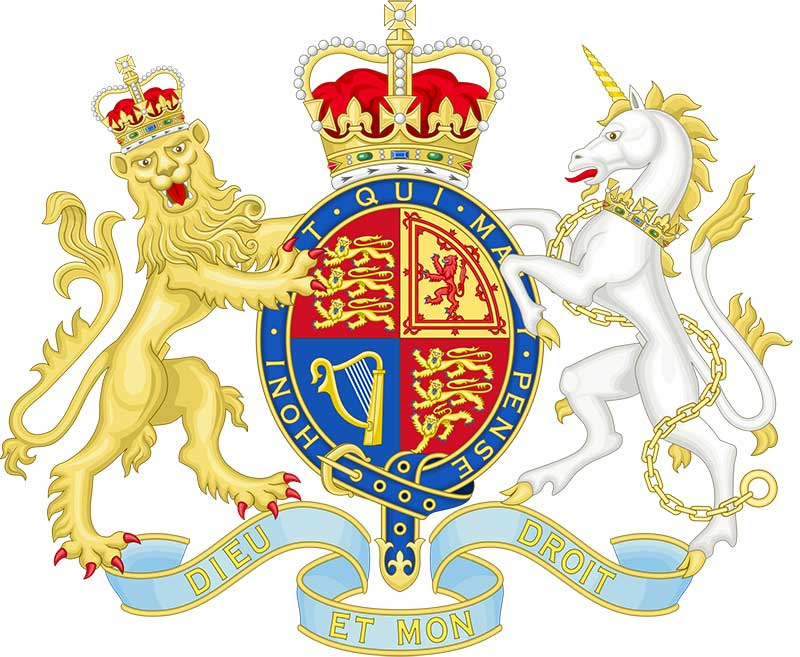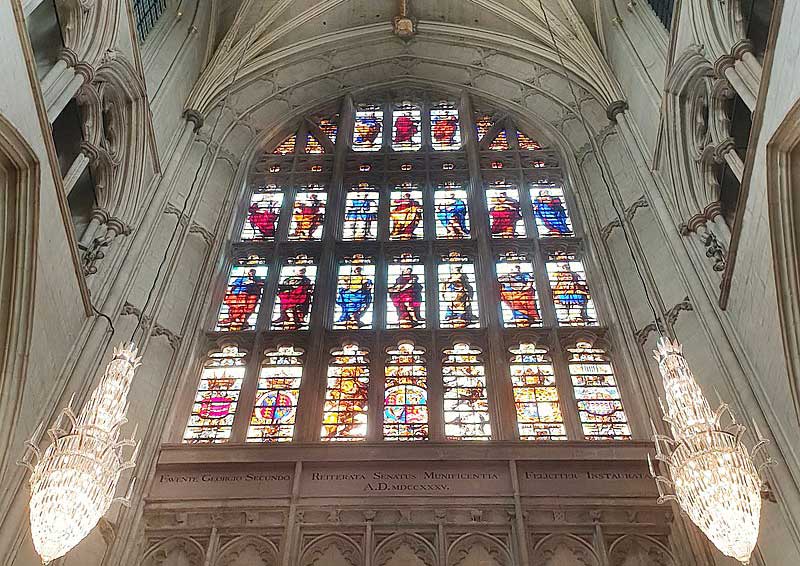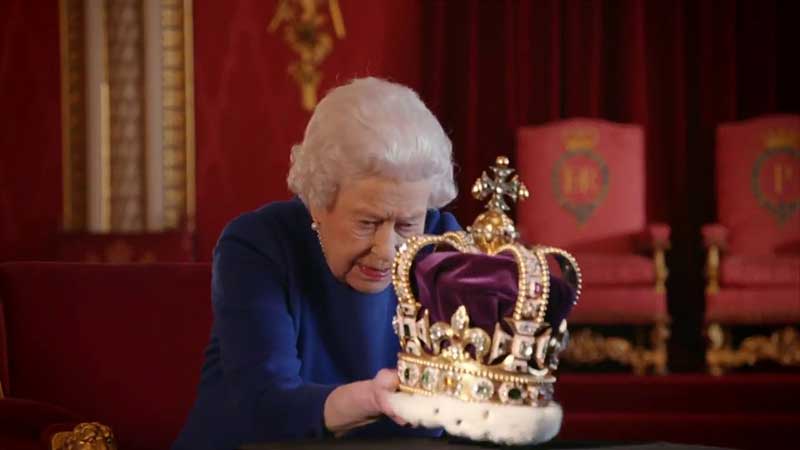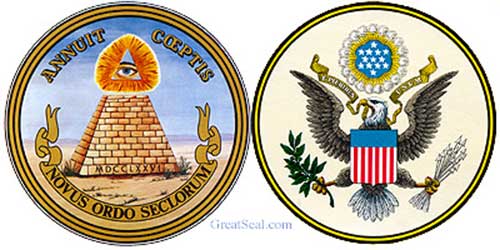
The magnificent heraldry of Britain’s Coats of Arms is deeply rooted in the heraldry of Israel, bearing little or no significance to England apart from her perceived and/or actual connections with the seed of Abraham. Even the magnificent west window of Westminster Abbey, under which every British monarch passes on his/her way to coronation, bears the figures of Abraham, Isaac and Jacob, the twelve patriarchs and Moses.
Each of Britain’s heraldic symbols and mottos mirror those found in the Old Testament relating to the Children of Israel in general - and to the Royal House of David and Joseph’s son Ephraim, upon whom Jacob bestowed the family birthright, in particular.
In the Old Testament, Joseph’s sons Manasseh and Ephraim are said to be connected with "a Fruitful Bough" and as being archers (Gen.49:22-23) “shooting arrows”. A bullock and unicorns are mentioned in Deuteronomy 33:13-16. Numbers 24:8 mentions a unicorn also.
There were standards on the four sides of Israel's camp (Num.2:2-3,10,18,25) - representing God's throne room in heaven (Ez.1:10; Rev.4:7). Judah's "east side" (2:3) had the "lion" (Gen.49:9). With that starting point, we know Reuben's "south side" (2:10) had the "firstborn" man (Gen.49:3; see also Deut.33:6) and Ephraim's "west side" (2:18) had the bullock (Deut.33:17) and Dan's "north side" (2:25) had the eagle (Ez.1:10; Rev.4:7) since that's all that's left.
Balaam compared Israel to a unicorn (Num.23:22), a lion, and talked about Israel's arrows (24:8-9). Israel is taken to safety on eagle’s wings (Ex.19:4; Rev.12:14). All these symbols occur frequently in British and US heraldry.

The first documented use of royal arms dates from the reign of Richard I (1189–1199). Royal emblems depicting lions were first used by Danish Vikings, lions having been adopted by the Germanic peoples around the 5th century as they embraced Christianity and symbolism relating to the Old Testament patriarchs.
The kings of Europe applied the symbols of the Royal House of David to their own kingdoms; they believed they, like David, had been appointed by God to rule, and therefore that Samuel’s prophecy - “Your house and your kingdom will endure forever before me; your throne will be established forever’” (2 Samuel 7: 16) – was being fulfilled through them.
The royal coat of arms of the United Kingdom is still the arms of dominion of the British monarch, currently King Charles III. Variants of the royal arms are used by other members of the British royal family, by the Government of the United Kingdom, and some courts and legislatures in a number of Commonwealth realms.
The coat of arms depicts the lion and unicorns, the young lion, and the Harp of David (1 Sam.16:23). At the centre of the arms is a quartered shield, depicting the three passant guardant lions of England in the first and fourth quarters, the rampant lion and double tressure flory-counterflory of Scotland in the second quarter, and a harp for Ireland in the third quarter. Surrounding the shield is the Order of the Garter, the United Kingdom's most senior order of knighthood. The supporters are a crowned English lion on the dexter (heraldic right), and a chained Scottish unicorn on the sinister (heraldic left).
Above the shield is a gold helmet, which has mantling of gold and ermine attached to it. On top of this is the crest, a crown with a crowned lion standing on it. Below the shield is a grassy mound, a type of compartment, on which are thistles, Tudor roses and shamrocks, representing Scotland, England and Ireland respectively.
In front of this is the Royal motto, Dieu et mon droit, a French phrase meaning ' God and my (birth) right. The Royal motto of England, "Dieu et Mon Droit" or "God and my (birth) right" is said to have first been used by Richard I (1157–1199) as a battle cry and the declaration of the belief in the divine right of the monarch to govern. It was adopted as the royal motto by King Henry V (1386–1422). The motto’s meaning is that the king is "Rex Angliae Dei gratia" ("King of England by the grace of God"), implying that the monarch has a God-given (divine) right to rule.
Another Old French phrase also appears in the full achievement of the Royal Arms: the motto of the Order of the Garter, Honi soit qui mal y pense ("Shamed be the one who thinks ill of it"), appears on a representation of a garter behind the shield. The Biblical equivalent is what God said to Abraham: "I will bless those who bless you, and curse him that curses you" (Gen12:3).
Among the millions who saw or heard the Coronation of King Charles III, there must have been many who wondered at the repeated references to King Solomon. Those familiar with the Old Testament scripture who have recognised that numerous important parts of the ceremony mirrored those which occurred when Solomon succeeded his father David on the throne of ancient Israel. In fact, from beginning to end, in word, act, and symbol, the Coronation ceremony proclaims the belief that the Celto-Saxon peoples are the continuation of the House of Israel, and that Britain's royal house and throne are the house and throne of David.

Sir James Thornhill designed the great west window of the nave which shows Abraham, Isaac and Jacob with the Twelve Tribes of Israel. Dating from 1735 it was made by William Price.
We see this, first of all, in the previously mentioned great west window under which the sovereign passes when entering the Abbey. In the top section are figures representing Abraham, Isaac, and Jacob. Below them are Jacob’s twelve sons, the fathers of the twelve tribes of Israel, together with Moses, the first ruler, and Aaron, the first High Priest of the Israel nation. Then, immediately below these, and between the official emblems of Moses and Aaron, is the British coat-of-arms. Such an arrangement is clearly intended to show national continuity, and thus is a pictorial declaration of the Israelitish identity of the British peoples.
The very first act of the Coronation ceremony saw the Archbishop of Canterbury presented King Charles III to the people with these words: “Sirs, I here present unto you King Charles III your undoubted King; wherefore all you who are come this day to do your homage and service, are you willing to do the same?” Then the people, represented by those in the Abbey, expressed their willingness by shouting, “God save the King.”
This is identical with the custom in Israel of old as recorded in 1 Samuel 10:24, where we read, “And Samuel said to all the people, See ye him whom the Lord hath chosen, that there is none like him among all the people? And all the people shouted, and said, God save the king.” As there is no record of such a custom among other peoples, the continuous use of it since ancient times clearly points to Britin's Israelite origin.
Even more striking is the fact that the Archbishop presents the Sovereign to the people in each of the four directions. The significance of this appears when we remember God’s promise to Jacob, the father of the Israel people, as recorded in Genesis 24:14: “And thy seed shall be as the dust of the earth, and thou shalt spread abroad to the west, and to the east, and to the north, and to the south: and in thee and in thy seed shall all the families of the earth be blessed.” Consequently, any message or question addressed to Israel would have to be sent to the four corners of the earth, and this is exactly what the Archbishop does in presenting the Sovereign for acceptance.
The second act of the ceremony is also significant. Here we see that when the Sovereign takes the Oath to rule in accordance with the Law, he does so in the immediate vicinity of a rough stone which Britain's most ancient legends say is Jacob’s pillow, the stone on which Jacob rested his head on that wondrous occasion when God made the promises to him recorded in Genesis 28. It is while seated on this stone, that he is anointed and crowned.
It is certain that such a stone or pillar (Gen. 28:18) existed in Israel of old, and that their kings took an oath and were anointed and crowned while standing by or on this stone. In 2 Kings 11:12-14 we read of Joash taking the Oath and being anointed and crowned standing “by a pillar as the manner was.” Thus the fact that Britain's Sovereigns take the Oath by this ancient stone and that they are anointed and crowned seated on it, is another witness to the fact of Britain's Israelitish heritage and the belief that its Throne is the Throne of David.
The act of anointing British Sovereigns is identical with that used in Israel of old, being made in exact accordance with the formula in Exodus 30:22-25. In considering the significance of this fact, we should note that God Himself is said to have dictated the formula for this oil, and that he gave two commands concerning it: It was to be used for the consecration of the Kings and Priests of Israel, and that it was NOT to be made for or used by anyone else.

HRH Queen Elizabeth II with the Crown of St. Edward
The ancient Crown of St. Edward is used in the actual crowning of the sovereign. A of special jewels, twelve in number, encircle its base. They correspond exactly both in number and name with those on the breastplate of Israel’s High Priest as recorded in Exodus 28.
This is most significant, for when the High Priest presented himself before God as the representative of the nation he wore a golden breastplate on which were twelve jewels, one for each of the twelve tribes of Israel. So also today, as for ages past, when British sovereigns present themselves before God in the Coronation service to dedicate themselves and us to God’s service, they wear a crown whose golden base is set with twelve jewels which are identical with those which represented the twelve Israel tribes on the High Priest’s breastplate.
Just as the twelve tribes of Israel are the basis of the kingdom of God, so the twelve jewels, emblematic of these twelve tribes, form the basis of the Crown. Just as the twelve tribes around the Tabernacle were divided into four groups, so the twelve jewels around the base of the crown are divided into four groups by four golden bands extending upward from the base.
Further, when Israel of old was encamped around the Tabernacle (Num. 2) each tribe encamped under its own banner or ensign. Then, ahead and above these, were the flags or standards of the four divisions into which the twelve tribes were divided. This too appears in the symbolism of the crown for around it are four special jewels set above those encircling its base.
Finally, above the actual crown we see a golden ball or orb surmounted by a cross, and from this cross two bands extend downward to encircle the orb. This completes a perfect picture, for this cross, above and encircling the globe, is the recognised emblem of Jesus, the Christ.” (1 Tim. 6:15; Rev. 19:16)
Although restored in 1661, the design of this crown has remained unchanged since the time of Edward the Confessor, a period of 900 years; so for that long, and perhaps much longer, it has been offering mute testimony to the Israelitish origin of the British peoples, and to the Davidic heritage of their Royal House and Throne.

Direct connections to the Old Testament patriarchs are also evident in the symbols depicted in the Great Seal of the United States of America. An eagle holds a fruitful olive branch and arrows in its talon behind a shield. (Gen.15:1; Deut.33:29; Ps.5:12; 91:4).
There is a “pillar of cloud” (Ex.13:21; 14:20; Num.9:17; Job 9:7; Ps.105:39) surrounding a radiating "glory" (Ps.63:2; Ex.13:21; Lk.2:9) shining from thirteen stars in a Star of David configuration. The motto is "E Pluribus Unum" or "Out of Many, One" (Gen.35:11; 48:19; Heb.11:12).
On the obverse side of America's seal are thirteen stars, thirteen letters in the motto, thirteen stripes in the shield, thirteen leaves and thirteen olives on the olive branch, thirteen arrows. The 50 stars stand for the 50 states of the union, and the 13 stripes stand for the original 13 states. Is it co=incidence that when Jacob blessed his sons prior to his death, there were 13 recipients and not twelve, with Joseph being represented by his two sons – Ephraim and Manasseh. On the reverse side is an unfinished pyramid with thirteen courses of masonry, and missing its apex stone. In its place is the “all seeing eye”. Known as a pyramidion, this missing uppermost piece or capstone is the pyramid’s chief corner stone; the pyramid being the only built structure to have one. This brings Matthew 21:42 immediately to mind - “the stone the builders rejected has become the chief corner stone”, and Psalm 118: 22, which Jesus was quoting. The Great Pyramid at Giza in Egypt is believed to be the pyramid depicted on the American Great Seal, as it is the only pyramid believed to have never had its chief corner stone set.
Annuit cœptis is one of two mottos on the reverse side of the Great Seal of the United States. The literal translation is "[He] favors [our] undertakings", from Latin annuo, and coeptum, literally meaning “He (God) has prospered our undertakings (or beginnings)”. The phrase has 13 letters. And echoes the sentiments of Deut.33:13-15 regarding Joseph. The name "Joseph" means "prosper" (Gen.30:24). "The Lord was with him (Joseph), and that which he did the Lord made it to prosper" (Gen.39:23).
The eagle itself is always associated with the heraldry of Israel. Ezek. 17:3-5. It is one of the loftiest of scriptural emblems. Her courage and farsightedness is stated in Job 39:28-30. Her swiftness is alluded to in Deut. 28:49. The remarkable phenomenon of the renewal of its youth is mentioned by David. Psa. 103:5. “He bore them on eagles’ wings” (Exod. 19:4) is the symbolism used to represent the escape of Israel from bondage to freedom. The eagle was the standard of the camp of Dan, which included Asher, Dan and Naphtali.
The olive branch, upon which cluster thirteen berries and thirteen leaves, is also a symbol of Israel, who is referred to in scripture as an olive tree. Jeremiah 11:16 says, “The Lord called thy name, a green olive tree,” and Paul speaks of Israel as an olive tree. Rom. 11:17-24. It is most significant that the dexter talon holds the olive branch with its thirteen olive berries and its thirteen leaves, the symbol of peace, but the sinister talon holds the thirteen arrows of war.
Israel, when she went against a city in battle, was commanded to follow these instructions. “When you march up to attack a city, make its people an offer of peace. If they accept and open their gates, all the people in it shall be subject to forced labor and shall work for you. If they refuse to make peace and they engage you in battle, lay siege to that city.” Deut. 20:10-12. First the enemy is offered the olive branch of peace and, if this is refused, then comes the arrows of war. This is a strategy the United States has adopted (though not always followed) in its perceived role as peacemaker to the nations.
The arrow had a special place in the heraldry of Manasseh, since he is Joseph’s son, and to Joseph the Lord had said, “But his bow remained taut, and his arms were strengthened by the hands of the Mighty One of Jacob, by the Shepherd, the Rock of Israel.” Gen. 49:24.

Design by W3layouts